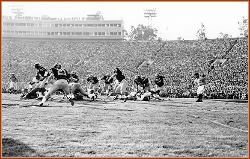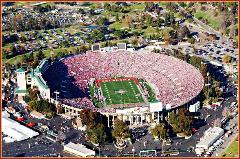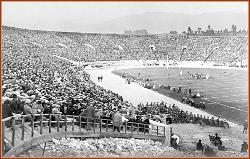



Ohio Stadium "The Horseshoe"
As early as 1913, Ohio Field at High Street and Woodruff Avenue was unable to
contain the crowds attracted to many Buckeye home football games, leading to faculty
discussion of moving the site elsewhere and building a new facility. The growing
popularity of football in Ohio led to the design of a horseshoe-shaped stadium,
conceptualized and designed by architect Howard Dwight Smith in 1918. A
public-subscription Stadium Campaign to fund the project was begun in October 1920
and raised over $ 1 million in pledges by January 1921, of which $975,000 was actually
honored.
The stadium was completed in 1922 by E. H. Latham Company of Columbus with
materials and labor from the Marble Cliff Quarry Co. at a construction cost of $1.34
million and a total cost of $1.49 million. The stadium's original capacity was 66,210,
astronomical in size at the time. Many university officials feared that the stadium would
never be filled to capacity.
Smith employed numerous revolutionary architectural techniques during the building of
the stadium. At the base is a slurry wall, to keep out the waters from the Olentangy
River. The stadium sits on the flood plain, giving it a precarious, but beautiful setting.
Instead of building a large bowl, like the previously constructed Yale Bowl or later at
Michigan Stadium, Ohio Stadium was designed to have an upper deck that would hang
over part of the lower deck, giving Ohio Stadium its "A", "B", and "C" decks. Instead of
employing numerous columns like those at Harvard Stadium, Smith designed double
columns that allow for more space between columns. The rotunda at the north end of
the stadium, which is now adorned with stained glass murals of the offensive and
defensive squads that comprise the Buckeye football team, was designed to look like
the dome at the Pantheon in Rome. The rotunda also features maize flowers on a blue
background which were the outcome of the dedication game against the University of
Michigan in 1922.
The first game in the stadium was against Ohio Wesleyan University on October 7,
1922, and brought a crowd of around 25,000, which left people concerned because the
stadium was only half full. This concern was put to rest at the stadium dedication
against Michigan on October 21. The crowd was announced at the game to be 72,000,
but no one is really sure how many people made it into the stadium. This attendance
mark was broken in a game against Michigan in 1925 when 90,411 came out to support
the Buckeyes; this is also the last time standing-room-only tickets were sold for a game.
(The stadium itself did not regularly sell out until after WWII, in the 20s and 30s most
games only drew in 20,000 or 30,000 fans, with many more attending the annual game
against Michigan.)
In 1923, a cinder track was built around the football field. The stadium became home to
the track and field team for OSU for many years.
Renovations
As time passed, minor adjustments raised the seating capacity to more than 90,000. In
1984, a new $2.1 million scoreboard was installed. The stadium was heavily renovated
from 1999 to 2000 -- the press box was replaced, additional seating was installed
above the existing upper deck and 81 luxury suites and 2,500 club seats were added. A
track and field-specific stadium had been built by the university nearby, thus the track
at Ohio Stadium was no longer needed. The track was removed and the field of play
was lowered by 14.5 feet to add additional seating closer to the field. The temporary
bleachers in the south end zone were replaced with permanent seating. However, the
south end of the stadium remains partially open, thus allowing the stadium to maintain
its noted Horseshoe configuration.
General improvements were also made in the seating and concourse areas. The result
of the $194 million renovation was a capacity that rose to 101,568. Eighty percent of
the cost of the renovation was funded by the sale of leases on the suites and club
seats, with the remaining 20 percent funded by donations and the sale of naming rights
for portions of the stadium. No public or university money was spent in the renovation
process.
In 1971, the natural grass field was removed, and AstroTurf was installed, complements
of a generous donation. In 1979, the surface was replaced with Superturf. In 1990,
natural grass made its return to the Horseshoe, a special grass called "Prescription
Athletic Turf." New field designs were put in place for the 1992 season and existed
through the 2006 season. During that last season problems with the natural grass
began to arise. After serious damage to the field during use in the spring of 2006 the
field never recovered and had to be resodded. That grass never took root due to bad
weather and The Ohio State University was forced to resod the field again only three
weeks after the old sod was laid. The University spent approximately $150,000 to
perform both soddings. Due to poor field quality, along with maintenance expense and
the ability to use the field year-round, OSU decided to replace the natural grass with
FieldTurf for the 2007 season. This new artificial turf looks and feels like real grass but
only requires very minimal upkeep.



Ohio Stadium photo from 2007 season. Half-Time of the 58-7 win over Northwestern.










